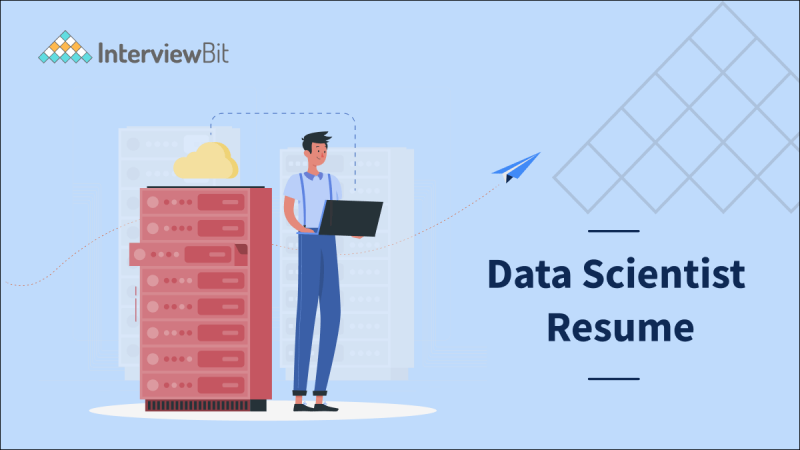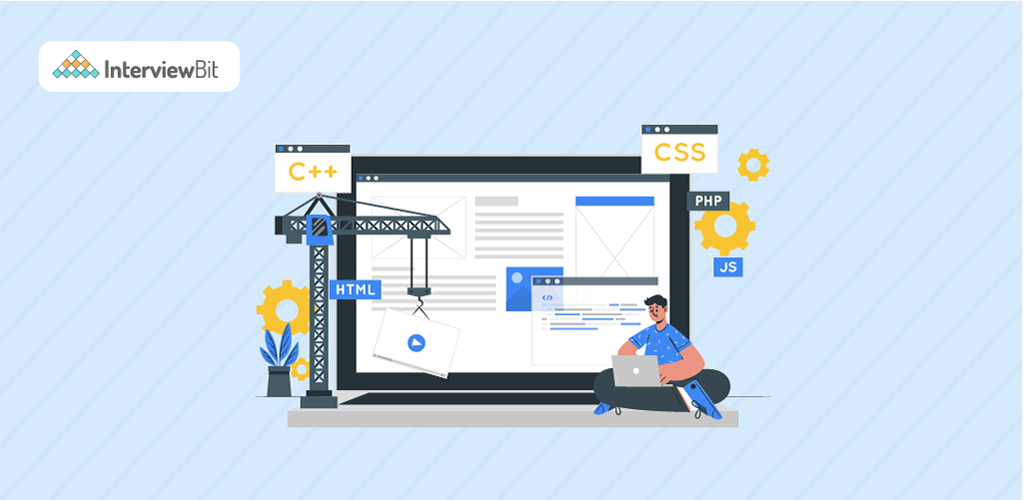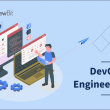Introduction
Data science is currently one of the most in-demand careers and will continue to remain so in the future. If you’re looking for a job in data science, you’ll need a strong data scientist resume and cover letter to stand out from the crowd.
Data is present in almost every industry imaginable, which is one of the reasons why businesses are becoming interested in data science. Another motivation of data science is the notion that data will continue to be an important part of our lives indefinitely. That said, it’s critical to keep up with the latest data science trends, as they may be beneficial to your company’s growth. The top ten data science trends for this decade are shown below:
- Big Data on the Cloud
- Augmented Analytics usage
- Data Cleaning Automation
- Natural Language Processing
- Quantum Computing for Faster Analysis
- Democratizing AI and Data Science
- Automation of Machine Learning (AutoML)
- Computer Vision
- Generative AI
- Blockchain in Data Science
Companies need a data scientist to do these jobs because data science pulls together subject expertise from programming, maths, and statistics to produce insights and make sense of data. Once they’ve figured out how to make sense of the data, they communicate it to the information technology leadership teams and use visualizations to comprehend the patterns and trends. Data scientists also use machine learning and artificial intelligence, as well as their programming skills in Java, Python, SQL, Big Data Hadoop, and data mining. They must have excellent communication skills to properly communicate their data-finding ideas to the organization.
Confused about your next job?
They also help to reduce risk. Data scientists have been taught to look for data that is unusual in some way. They use statistical, network, path, and big data approaches to forecast danger and use them to produce alerts that assure prompt responses when odd data is detected.
They assist in the delivery of pertinent products. One of the benefits of data science is that it allows businesses to determine when and where their items sell the best. This can aid in the delivery of the correct items at the right time—as well as the development of new products to fulfill the needs of customers.
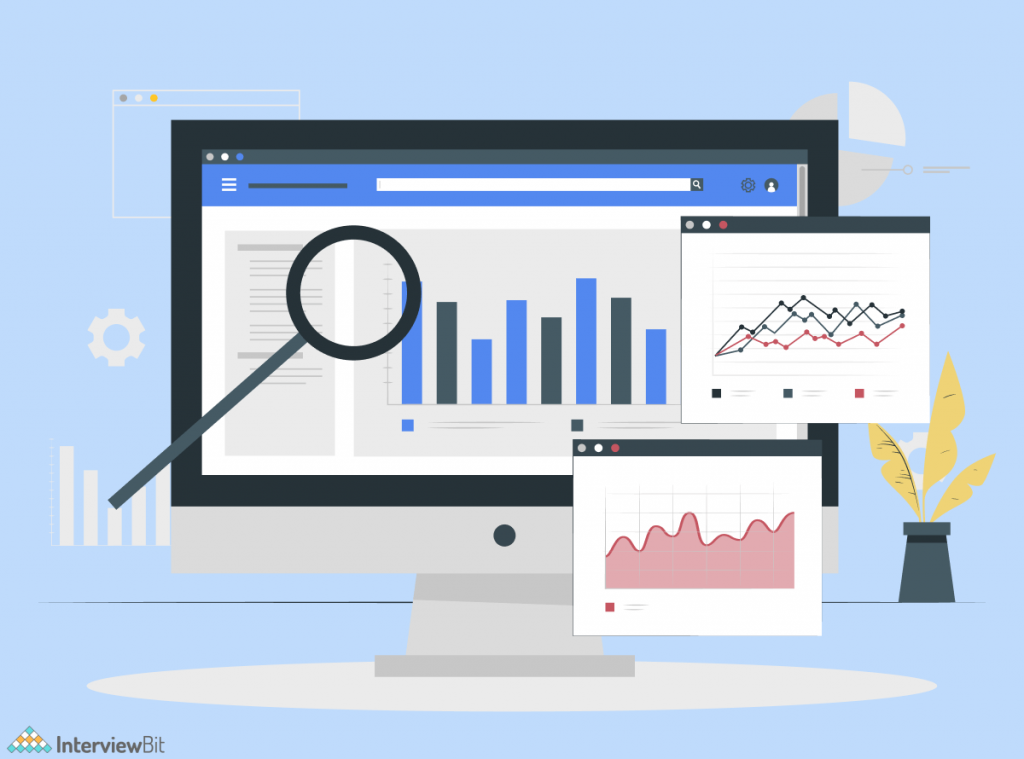
In this blog, you will learn about:
- A sample data scientist resumes better than most.
- How to ace your data scientist job description on a resume.
- How to write a resume for data science jobs that gets the interview.
- Why picking the right few data scientist qualifications is the #1 key to getting hired.
Data Scientist Resume Format for Freshers and Experienced
A typical resume is divided into various parts. In this section, you will come across the best practices to write a job-winning resume.
Before diving deeply into each section of the resume, let’s look into some common useful tips:
- Make section heads bold and larger.
- Use a classy typeface for your resume.
- Use proper white space.
- Create a resume that is as long as you need it to be. It is acceptable to have a resume that is longer than one page. It’s not a good idea to skip over crucial aspects of your profession.
- Set the margins to a single inch on both sides.
- Use reverse-chronology order for your experiences.
- Consider using a single or 1.15 line spacing.
- Choose a relevant template that showcases the information in a clear manner.
1. Personal Information
It is a crucial section concerning your contact information and your activities on social media sites like Linkedin, Stackoverflow, Medium, etc. You cannot afford to make mistakes here. The interviewer comes across several resumes with incorrect email addresses or phone numbers which it becomes difficult for them to convey the result to their candidates. So there is always a need to cross-check this section before submitting your resume. The mandatory fields include:
Full Name
Title – “Data Scientist”
Phone Number
Email Address
Location (Optional)
On the other hand, if you are active on GitHub for your data science projects or your contribution to an open-source project, then include the link to your profile. By doing so, you can showcase your skills which will help to stand out your application and increase your selection chances for further rounds. The same point is valid for other platforms like Medium, Linkedin, etc.
So it’s less important to be creative here than accurate here.
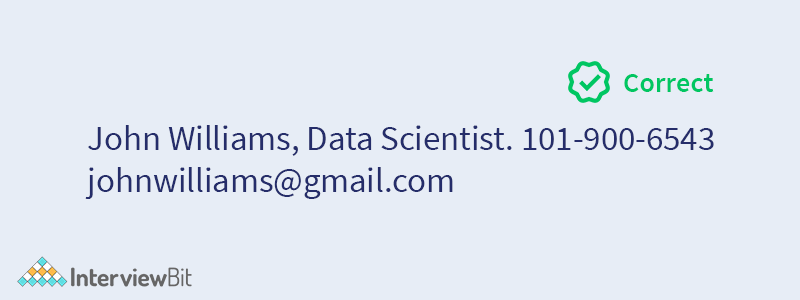
2. Summary
This section is placed on the top of the resume. It is the short description that summarizes your whole resume and at this point recruiters and hiring, managers get the idea of whether to proceed further or to reject the candidate. You have to summarize your years of experience, skills, and education in an easy-to-read format. This part shouldn’t exceed 4-5 lines. Firstly, tell about the years of experience you have as a data scientist and what was your role in previous companies (if experienced), secondly, mention your primary technical skills, and lastly, you can tell about your important certifications relevant as a data scientist role. The format may vary.
By going through all the information here, recruiters decide whether you are a good fit for their company or not. The main aim is to impress the hiring team so that they get forced to look at the best part of your resume and know more about you. This section needs to be short and creative because there are hundreds of resumes that recruiters come across in a single day, so they don’t have time to study the whole resume of each candidate. They spend a few seconds on each resume, so you need to be serious about this part as it is the deciding factor for your job.


In the above example, the incorrect section sounds easy to go to, not much relevant information is provided by the candidate that can influence the recruiter to shortlist it. But the correct section is way better, it is emphasizing more on candidates’ skills and achievements that can make recruiters shortlist them.
3. Skills
This section conveys your technical and soft skills. The point here is that you need to be specific about the role you are applying for (here Data scientist). Your skills should revolve around data science, machine learning, NLP, artificial intelligence, and related domains.
Mention the skills that convince your recruiters that you bear most of the required technical skills and software knowledge for the applied role. This is the time to showcase your knowledge related to programming languages, data science frameworks, libraries, tools, etc.
Try to keep the technical skills and soft skills separate so that they can be distinguished. It enables an easy understanding of your skills to your recruiters.
Do not exceed the count of your skills, be specific. Mention only those which are most important for the data scientist role. Most importantly, you should be confident about your skills, for example, add only those languages in which you are comfortable coding because the interviewer might ask you to code for a problem statement just to test your coding skills in the mentioned programming language. Do not brag about your skills here. Just mention your expertise areas and if you have beginner knowledge of any skill and you want to add it to the bucket list as it’s crucial for the data scientist role, you may write (beginner).
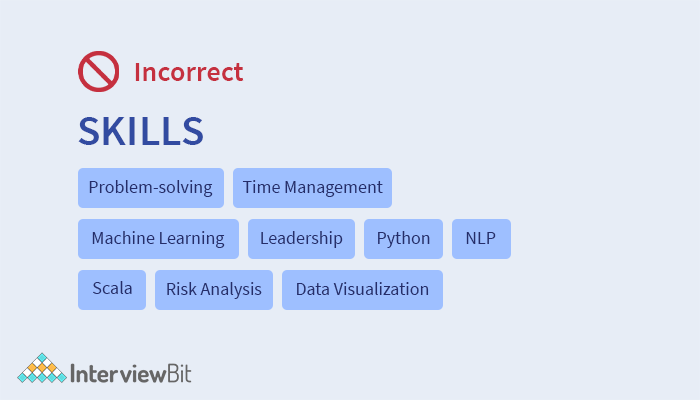
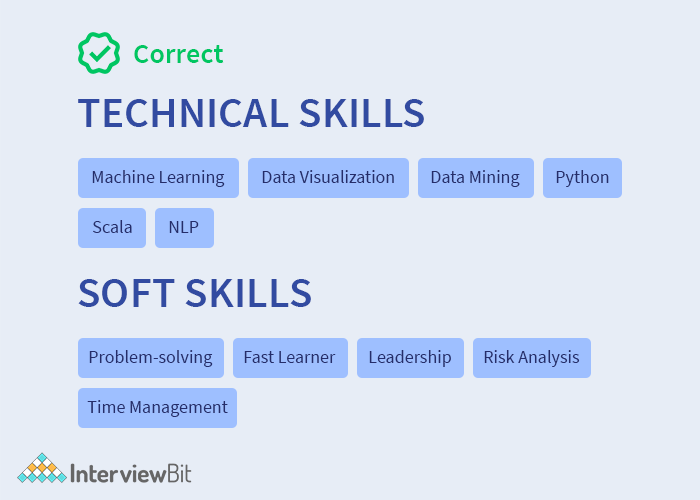
4. Education
In this part of the resume, you have to include your education in reverse chronological order. This section may vary for freshers and experienced individuals. If you are a fresher, you can include the following information:
- College degrees (Degree name, college name, GPA score)
- Intermediate school (School name, percentage/GPA score)
- High school (School name, percentage/GPA score)
If you are an experienced individual:
You may skip mentioning your schooling and write only about your bachelor’s and master’s degrees. The main focus will be on the Work experience part.
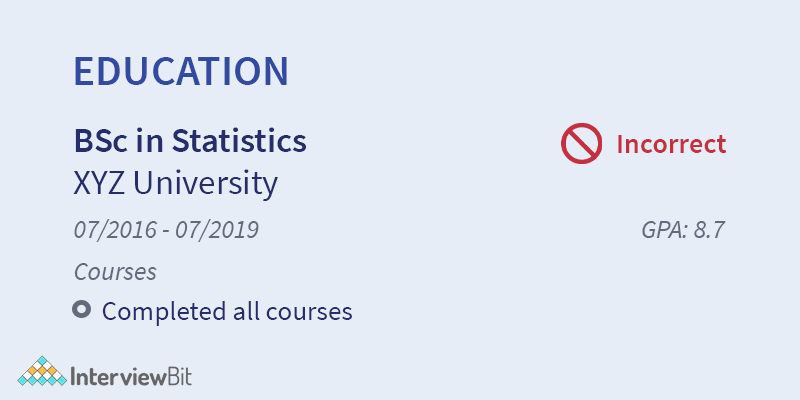
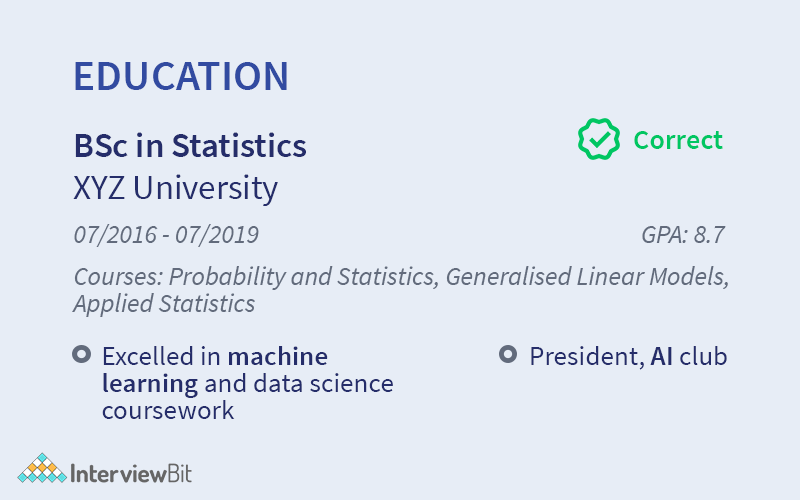
In the above example, you can see the correct way is to properly address your education details to the hiring team so that they can have a clear knowledge of whether the candidate has done relevant courses as a part of their education.
5. Project
At this part of your resume, you may expect various kinds of questions from your interviewer which will describe your technical skills and soft skills. You have to include your data science-related projects that describe your capability to work on company-level projects. Include the following details about your every project:
- Title
- Your responsibility
- Technologies used
- State the quantitative result of the project.
If you’re just starting in your data science career and don’t have many options, including academic tasks you had to complete in this field or related fields.
Note: It’s a good practice to update information about your projects in your Github profile.
Don’t brag about your roles and responsibilities because interviewers may cross-question for the same so as to check your skills like leadership team management, time management, etc.
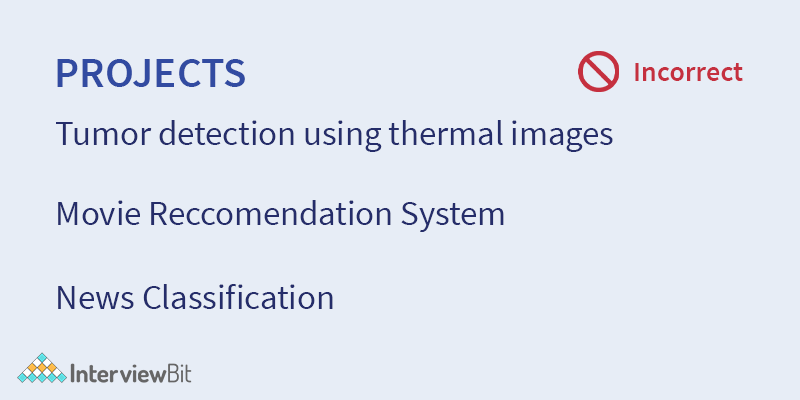
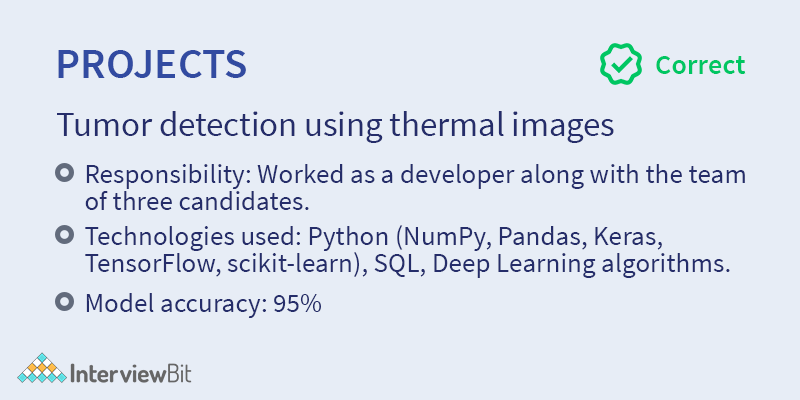
6. Work Experience
This section is more important for experienced individuals. The basic structure of adding your work experience is as follows:
- Position name
- Company Name
- Dates
- Responsibilities & Achievement
- Technologies you worked on
Your most recent employment should be listed first, followed by the job before that, and so on in chronological sequence.
A few factors influence how far back you can go in terms of experience. You usually don’t want to go back more than five years.
Keep in mind that, while you don’t have to provide everything about your experience, you should make sure that whatever you do include appears to be seamless. For recruiters and hiring managers, gaps in your work experience section of more than six months are a huge red signal. If you have a gap like this, you should surely explain it on your resume.
Make sure your job description focuses more on accomplishments rather than responsibilities. Employers want to see what you did, not simply what you said you would do.
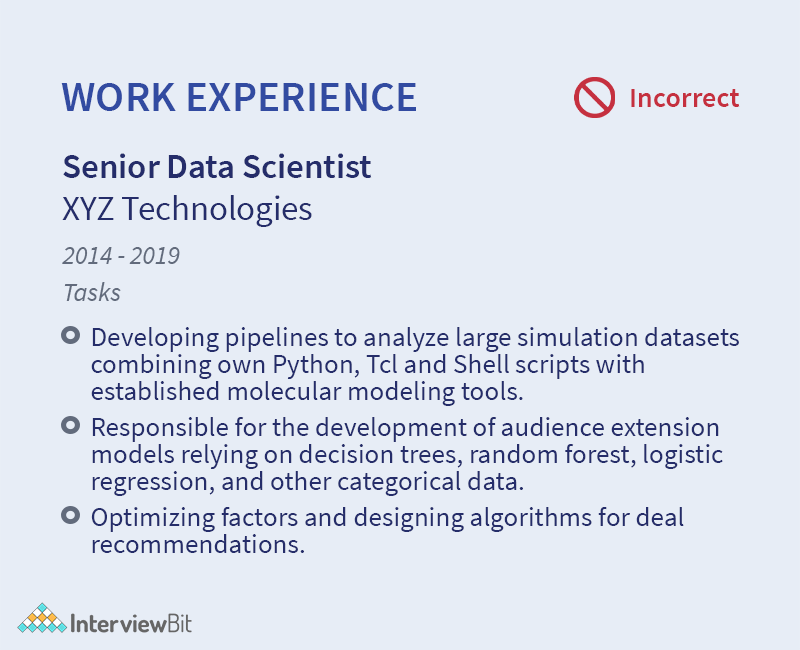
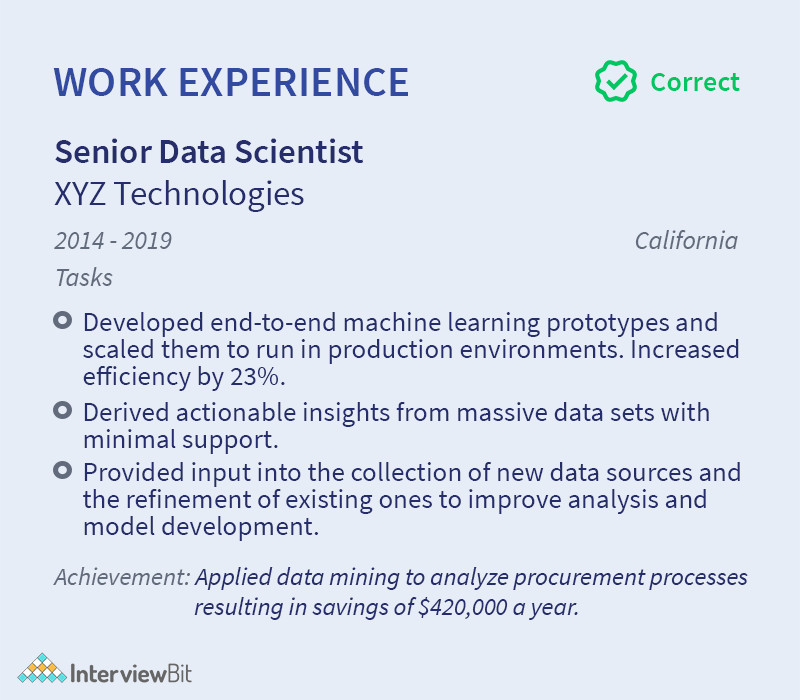
7. Awards and Certifications
Now you have a good chance to stand out from your resume from other applications. In this section, you can add your achievements that showcase your skills in the field of data science. If you don’t have one, you can add any accomplishments related to programming competitions and technical exams that you have appeared for. This part should have something unique. It will clearly show how much you could be a beneficial resource for the company.
Secondly, you can include your machine learning and data science-related certifications that helped in boosting your skills. This will build confidence in choosing you for the applied role.

8. Interests and Hobbies
Why would a recruiter need to know about your hobbies and interests, and what does it mean? You might think.
Your hobbies, on the other hand, disclose more about who you are as a person.
If you have the space, include a hobbies section on your resume as a simple approach to add personality.
Consider what you’re attempting to communicate to potential employers with your hobbies and interests before putting them on your resume. Employers can get a sense of how you spend your time and what additional skills you have by listing your hobbies.
On the other hand, interests may suggest areas you’re actively researching or want to research, which could make you a strong fit for the organization.
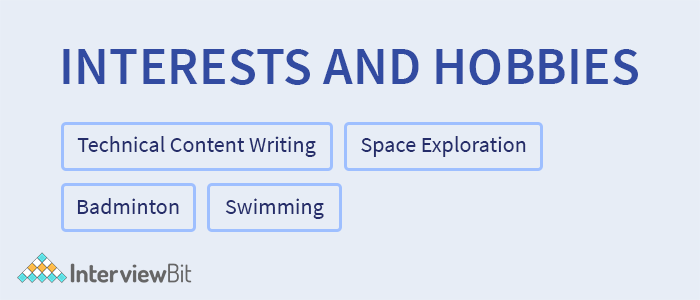
Data Scientist Resume Sample
Additional Tips
Following are some of the additional tips that would be helpful in preparing your resume that may be useful in providing you with your dream job:
- Resumes should be customized for each position and organisation to which you are applying. To learn more about the company’s work, mission, and beliefs, visit their website and follow them on social media. Then think about how you may contribute as a Data Scientist.
- It’s an art in itself to communicate succinctly why you’re the best candidate for a job.
- Choose straightforward action verbs (resolved, trained, upgraded, improved, designed, directed, established, etc) that highlight your achievements and describe how you contributed to a team or project.
- Project work is very beneficial if you don’t have a lot of experience. As a result, put more emphasis on data science initiatives and learnings.
- Make a thorough spell and grammatical check. Demonstrate to employers that you are meticulous and detail-oriented. A second set of eyes might be beneficial, so have a friend or peer look through your resume.
Conclusion
You’ve given yourself the best possible chance of landing that data scientist job if you followed all of the preceding suggestions.
Let’s summarise everything we’ve learned so far:
- Prioritize the reverse-chronological format for your data scientist resume, and then follow the content style criteria.
- To get the recruiter’s attention, begin your resume with a summary or objective.
- Pay more attention to your accomplishments than to your responsibilities.
- Don’t stray from the path; be specific and give your relevant information for data scientist jobs.
- Create a compelling résumé for a winning application.
FAQs
1. How do you list data science skills on a resume?
Ans. Include technical talents that are applicable to data science, with your strongest skills stated first. Examine the job description and see if your abilities match those needed for the role. To keep your talents section tidy, easy to read, and attract attention to significant skills, use bullet points.
2. What are the skills of a data scientist?
Ans. Following are some of the technical skills required as a data scientist.
- Data analysis
- Data wrangling
- Data modelling
- Statistics
- Data visualization
- Programming
- Quantitative analysis
- Machine learning
Following are some of the tools that can be added to a data scientist resume:
- R
- Python
- SAS
- SQL
- Scala
- MATLAB
- SQL Server
- NoSQL
3. What should a data scientist’s resume look like?
Ans. A data scientist’s resume should be well-organized that convey all the required information to the recruiter. It should be data science-related fields specific, otherwise, there is a chance of rejection.
Following is a typical structure that should be followed while creating a resume:
- Contact information
- Profile/Summary/Objective
- Experience
- Projects
- Education
- Skills
- Additional Sections (Awards, Certifications, Hobbies/Interests)
4. How can I improve my data science CV?
Ans. To begin, select a nice design for your CV. An excellent CV should reassure the recruiter about your problem-solving abilities and how you will help the company achieve growth and return on investment. Your CV should detail your experience as a data scientist and the various projects you worked on during that time.


